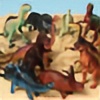HOME | DD
 DragosAndrei — Velociraptor Mongoliensis 2
DragosAndrei — Velociraptor Mongoliensis 2

#collision #cretaceous #dinosaur #meteor #mongolia #mongoliensis #pterosaur #velociraptor #winter #maniraptoran #eumaniraptora #enantiornithes #noripterus #birdlikedinosaurs #maniraptoriformes #paravaes
Published: 2016-12-08 11:14:25 +0000 UTC; Views: 1160; Favourites: 6; Downloads: 3
Redirect to original
Description
The velociraptor was reconstructed from a complet skeleton and the feathers were interpreted from the information found on the the genus and other maniraptorans.The background is changed...its in the winter period of the year + a meteor collision....It may not have snowed in the winter in the late Cretaceous but i think that it was possible with exceptions in colder than normal periods...either way its an interesting scene. Animals: Velociraptor Mongoliensis, Noripterus Complicidens,a flock of enantiornithe birds, Protoceratops Andrewsi and a hymenoptere (ancient wasp).
Related content
Comments: 4

that's pretty cool, but I don't think it's possible for the velociraptors or other dromaeosaurs to bend their tail like that. They could only bend their tail at the base.
👍: 0 ⏩: 1

Teren îs a velociraptor specimen witch was found with a S curve articulated tail..and I saw many new representations in museums with bent tails...in fact no one knows for sure.
👍: 0 ⏩: 2

Thank you for your opinion! I am still learning on making these reconstructions, until a week ago it was a pain to rectify any mistake because i was drawing with the mouse, now it`s much easier to do so with the graphical tablet i managed to buy.
👍: 0 ⏩: 0

The likely cause of the bendy tail is preservation, many Dromaeosaur specimens have become crushed from being pressed under soil and rock.
Dromaeosaurs have tail vertebrae with long bony rods that weave together, you see it on a lot of specimens.
👍: 0 ⏩: 0


















